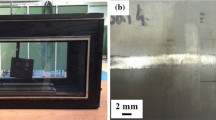Abstract
Alloy 718 suffers from microfissuring in the weld heat-affected zone, and compositional, structural and mechanistic causes of this defect have been examined. Both bulk sulfur and bulk carbon increase microfissuring, and heat treatments typical ofhomogenization, solution annealing and age hardening reveal that microfissuring is sensitive to the microstructural and chemical distributions established during heat treatment. Increased grain size increases microfissuring more than heat treatment or bulk chemistry. The mechanistic cause of microfissuring, constitutional liquation of niobium carbide and Laves phases, produces intergranular liquid films with wetting angles that are dependent on the chemical composition of the grain boundary region prior to welding. Microfissuring also correlates with the temperature dependence of the intergranular liquid wetting angle in the heat-affected zone.
Similar content being viewed by others
References
M. Prager and C.S. Shira, “Welding of Precipitation-Hardening Nickel-Base Alloys,” Welding Research Council Bulletin, #128 (1968).
E.F. Nippes and W.F. Savage, “Development of Specimen Stimulating Weld Heat-Affected Zones,” Weld. J., 28, Res. Suppl. (1949), p. 534–s.
D.S. Duvall and W.A. Owczarski, “Further Heat-Affected Zone Studies in Heat Resistant Nickel Alloys,” Weld. J., 46. Res. Suppl. (1967), p. 423–s.
W. Yeniscavich, “A Correlation of Ni-Cr-Fe Alloy Weld Metal Fissuring with Hot Ductility Behavior,” Weld. J., 49, 45, Res. Suppl. (1966), p. 334–s.
R.G. Thompson and S. Genculu, “Microstructural Evolution in the HAZ of Inconel 718 and Correlation with Hot Ductility Test,” Welding Journal, 62 (1983), p. 337–s.
C.D. Lundin, “A New Approach to the Study of Hot Cracking in Fusion Welds,” Ph.D. Thesis, RPI (1966).
W.F. Savage, E.F. Nippes and G.W. Goodwin, “Effect of Minor Elements on Hot-Cracking Tendencies of Inconel 600,” Weld, 56. Res. Suppl. (1977), p. 245–s.
R.G. Thompson, J.J. Cassimus, D.E. Mayo and J.R. Dobbs, “The Relationship Between Grain Size and Microfissuring in Alloy 718,” Welding Journal, 63 (1984), p. 91–s.
A.C. Nunes, personal communication, NASA-MSFC, EH-42, Huntsville, AL 35812.
G.M. Ecer, personal communication, Rocketdyne Div., Rockwell International, 6633 Canoga Ave., Canoga Park, CA 91303.
E.G. Thompson, “Hot Cracking Studies of Alloy 718 Weld Heat-Affected Zone,” Weld. J., 48, Res. Suppl. (1969), pp. 70–s–79–s.
T.J. Morrison, C.S. Shira and L.A. Weisenberg, “Effects of Minor Elements on the Weldability of High Nickel Alloys,” Proceedings of the Weld. Res. Symposium, 93 (1967).
T. Kelly, “Investigation of Elemental Effects on the Weldability of Cast Nickel-Based Superalloys,” Advances in Welding Science and Technology, Stan David, ed., ASM International (1987).
R.G. Thompson, D.E. Mayo and B. Radhakrishnan, “The Relationship Between Carbon Content, Microstructure and Intergranular Hot Cracking in Cast Nickel Alloy 718,” submitted to Met. Trans., 1988.
R.G. Thompson, B. Radhakrishnan and D.E. Mayo, “Grain Boundary Chemistry Contributions to Intergranular Hot Cracking,” paper presented at Interface Science and Engineering ′87 Conference, Lake Placid, NY, and submitted to the Journal De Physique.
J.J. Pepe and W.F. Savage, “Effects of Constitutional Liquation in 18-Ni Managing Steel Weldments,” Weld. J., 46 (1967), pp. 411–8–422–s.
W.A. Baeslack III and D.E. Nelson, “Morphology of Weld Heat-Affected Zone Liquation in Cast Alloy 718,” Metallography, 19 (1986), pp. 371–379.
R. Vincent, “Precipitation Around Welds in Inconel 718,” Department of Physics, Bristol University (1981).
J.A. Williams and A.R.E. Singer, “A Review of the Mechanisms of Hot Short Cracking,” The Journal of the Australian Institute of Metals, 11, 2 (1968).
B. Radhakrishnan and R.G. Thompson, “A Quantitative Microstructural Study of Intergranular Liquation and Its Relationship to Hot Cracking,” Accepted for publication in Metallography.
C.S. Smith, “Grains Phases and Interfaces: An Interpretation of Microstructure,” Trans. of AIME, 175, 175 (1948).
Additional information
R.G. Thompson received his Ph. D. in materials science and engineering from Vanderbilt University. He is currently an associate professor in the Department of Materials Engineering at the University of Alabama at Birmingham. Dr. Thompson is also a member of TMS.
Rights and permissions
About this article
Cite this article
Thompson, R.G. Microfissuring of Alloy 718 in the Weld Heat-Affected Zone. JOM 40, 44–48 (1988). https://doi.org/10.1007/BF03258151
Published:
Issue Date:
DOI: https://doi.org/10.1007/BF03258151




